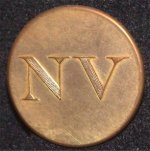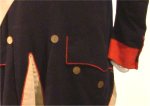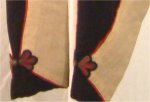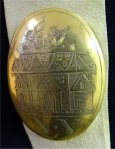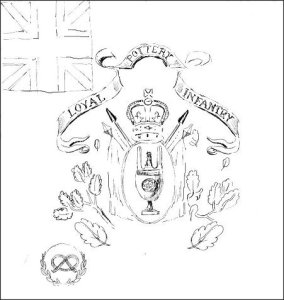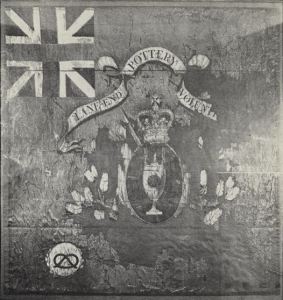In Staffordshire no volunteer units, other than the county yeomanry, were formed with the legislation of 1794. All Staffordshire infantry volunteers raised in the 1790’s originated during the later period of 1797-8. On this page are notes on the organisational basics, and dress and equipage where known, of the volunteer infantry of Burton, Newcastle-under-Lyme and Walsall, and the armed association infantry of Bilston, Burslem, Eccleshall, Lichfield, the Potteries, Stafford, Stone, Tamworth, Wednesbury, West Bromwich, Whittington and Wolverhampton, all in alphabetical order. All were disbanded in 1802 or before, and their successor units of 1803 are not included here. Some of these associations also included troops of cavalry, which are examined on a separate page.
Earliest dates of commissions, as best known to me, are taken from the War Office list of 1799 (sixth edition) or from the London Gazette. Not surprisingly, information on the dress and equipment of armed associations is sparse, and is often limited to brief descriptions, sometimes not fully determined, in resolutions passed by meetings at their formation. In too many cases I have been unable to find even that much. With one exception, these infantry units, where known, wore the dark blue coats and round hats typical of armed associations; this semi-civilian style not only afforded a relatively economical uniform but also asserted their identity as being distinct from that of the regulars or militia.
If new information arrives it will be added. Click all images to enlarge.
Bilston Loyal Association / Bilston Volunteer Association
Earliest commissions dated 18 June 1798. Two companies – commissions for second company dated 20 August. Captains Samuel Proud, Thomas Taylor. Associated with the Bilston Volunteer Cavalry.
Colours were presented to the infantry by Mrs Bickley on 22 October 1799.
[Staffordshire Advertiser, 26 October 1799.]
Burslem Volunteers / Burslem Tunstall, &c. Volunteer Association
Earliest commissions dated 12 June 1798. One company. Captain William Sneyd.
Burton Volunteers / Burton-upon-Trent Volunteers
Captains John Peel and Abraham Hoskins, Peel being the senior, then Major Comm, John Peel. Date of earliest commissions 14 April 1798. Initially two companies.
Their first public appearance in full uniform and under arms was expected to be in May 1798, but was actually in June. The corps included a band.
A committee meeting of 11 March 1799 recorded that expenses to date paid for the corps amounted to £578 19s 3½d, and that the account “for Arms &c” from a Mr Noon totalled £371 1s.
[Staffordshire Advertiser, 16 June 1798. Derby Mercury, 21 March, 26 April 1798.]
Cheadle Military Association
The Staffordshire and Birmingham newspapers advertised the resolutions of a meeting on 7 May 1798 for the formation of the Cheadle Volunteers as a military association, which suggests that this may have been at Cheadle, Staffordshire, for which no volunteer corps or association is recorded. However, the names involved indicate that this was Cheadle in Cheshire.
[Staffordshire Advertiser May 5 & 12, 1798.]
Eccleshall Military Association
On 11 May 1798 a meeting was held at Eccleshall that resolved to form a company of association infantry, with John Turton as captain, and two others as lieutenants. No volunteer corps or association for this location appears in the 1799 List, and neither do the names of the intended officers; it appears that the corps was not realised, or that its offer to government was not accepted.
Resolutions of the meeting, largely non-committal in nature, included:
That each person … shall provide his own Uniform, which shall consist of such Colours and Materials, in such Form, and with such Buttons and Decoration as shall be determined by the Majority of a Committee …
That each Member shall either subscribe for or shall supply his own Arms and Accoutrements …
That a Subscription be opened to defray the expences of purchasing Arms and Accoutrements …
[Staffordshire Advertiser, 19 May 1798.]
Lane End &c Armed Association
Earliest commissions 4 June 1798. One company. Captain William Turner. (See also below for the Lane End Volunteers of 1803 as successors to the Loyal Pottery Volunteers.)
On 18 September 1800 a pair of colours was presented, the King’s colour by Miss Gresley, the regimental colour by Mrs Turner. The newspaper report noted that “The Ladies who presented the colours were richly dressed in the uniform of the corps”.
[Staffordshire Advertiser, 27 September 1800.]
Lichfield Loyal Association / Lichfield Volunteer Infantry
Earliest commissions dated May 21 1798. Battalion 400 strong by 1800. Major St George Powell Bowles, Major William Phillips Inge, Captain Thomas Webb Greene. Colours presented 30 September 1799.
From initial resolutions:
That such of the Friendly Societies, where there are members exceeding the Age of Forty, yet very able and effective Men, do form themselves into a Corps or Company, to be called PIONEERS, and to carry such Arms, as Government shall think proper to intrust them with, namely, Pikes and Broad Swords, or Hangers …
That another Company do consist of Journeymen, Apprentices and Servants …
That these two Bodies of Volunteers shall at the Charge of Government be properly Accoutred, but each to pay Seven Shillings and Sixpence on the delivery of a Drill Frock to him (which then becomes his own Property,) in which he is to learn and perform his Exercise, for the Preservation of his own Wearing Apparel.
That the other Body of Volunteers shall be comprised of able and effective Men … to be Accoutred or Armed, at all times by Government, as directed by the late Act of Parliament.
… that each Company shall consist of FIFTY MEN (exclusive of Commissioned Officers) namely, Forty five in the Ranks, two Serjeants, two Corporals, and one Drill Serjeant, as also two Boys, the one as Drummer, the other as Fifer: each Serjeant to carry a Halbert, and wear a Sword or Hanger.
.. Each commissioned and non commissioned Officer to cloath himself in, and wear at his own expence a certain Uniform, or Dress, to be fixed upon by a Committee …
That the drill Frock shall be worn by each Volunteer at the Time of Exercise …
[Appendix to Howard Clayton, Coaching City, Dragon Books, n.d. (1971?) Capt Thomas Fernyhough, Military Memoirs of Four Brothers …, London, 1838.]
Newcastle Volunteers / Newcastle under Line Volunteers
The corps was formed at a meeting of 3 March 1797. Earliest commissions 10 May 1798. In 1801 comprised one battalion company, one grenadier, one light. Major Sir Thomas Fletcher. Drums and fifes.
On Monthly Days a Dark Blue Frock with Red Cape & Cuffs, lined and the Flaps faced with white, and Red Hearts on each, Gilt buttons with N.V. Stamped on, White waist-coat & breeches, buttons as frock, White stockings, black half-gaiters, Round hat with red & white feather, Black stock or handkerchief, hair powdered, tyed with Rosette. N.B. – on other parade days, White Pantaloons may be worn if preferred.
Notes: no lapels. “Flaps”: turnbacks. No fur crest to round hat.
Sergeants with swords, sashes, pikes. References in 1802 to hats and feathers for musicians, camp colours, painted stand of colours.
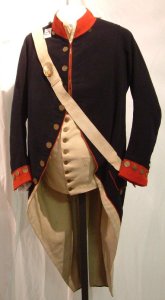 [Staffordshire Record Office D(W)1788, parcel 1, bundle 5: card, muster roll, accounts.]
[Staffordshire Record Office D(W)1788, parcel 1, bundle 5: card, muster roll, accounts.]
The coat, waistcoat, breeches and sword belt of Major Thomas Fletcher are kept by the Staffordshire Regimental Museum, and are described, though not identified, by G Archer Parfitt in the MHS Bulletin of August 1984. The coat, waistcoat and belt are currently on display. The coat and waistcoat are both cut quite long, in a slightly dated style, perhaps because the wearer was obviously very stout in build.
The coat has a scarlet collar and cuffs, the front edges, turnbacks and pocket flaps edged in scarlet. The front has eight large buttons, the same size also used on the cuffs, rear waist and below the flaps. The front button holes are worked in dark blue twist. At each shoulder is a small button, with a blue cloth loop at the point of the shoulder, for the epaulettes, now missing; there are also two small buttons at the front lower edge of the collar for suspension of the gorget. The turnback ornaments are not exactly “hearts” as specified above, but pairs of scarlet trefoils edged in gold lace on a dark blue ground.
The waistcoat fastens with 15 small buttons, and has side pockets. All coat and waistcoat buttons are gilt, with diagonally hatched Roman capitals “N V”. The white belt carries an oval gilt plate, slightly convex, showing an incised and detailed design of the arms of Newcastle-under-Lyme above “N V”. (My thanks to Jonathan Rogers for the use of his images of the waistcoat and belt plate.) The white breeches, not currently on display, have five buttons at each knee.
- photo by Jonathan Rogers
- photo by Jonathan Rogers
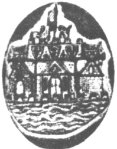 A photo made by Philip Haythornthwaite around 1983, possibly from an auction catalogue, shows, none too clearly, another belt plate, or a fragment of a plate, with arms that can be identified as those of Newcastle-under-Lyme – a turreted castle over water. I have no other details. This could perhaps be identified with the 1798 formation of the Newcastle Volunteers, though it does not show the “N V” noted above on the Fletcher plate.
A photo made by Philip Haythornthwaite around 1983, possibly from an auction catalogue, shows, none too clearly, another belt plate, or a fragment of a plate, with arms that can be identified as those of Newcastle-under-Lyme – a turreted castle over water. I have no other details. This could perhaps be identified with the 1798 formation of the Newcastle Volunteers, though it does not show the “N V” noted above on the Fletcher plate.
At the March 1797 meeting a subscription was opened to purchase arms and accoutrements, which were to be the common property of the corps.
[Staffordshire Advertiser, 11 March 1797.]
Loyal Pottery Volunteers / Staffordshire Pottery Armed Association / Loyal Pottery Association Infantry
Raised in Hanley, Shelton and Stoke. A meeting to raise two companies of infantry was held at Hanley on 20 April 1798. Earliest commissions 21 May 1798. Two companies. Captain Charles Bagnall, Captain John Tomlinson. Included a band. Associated with the Loyal Pottery Volunteer Cavalry.
The meeting of April 1798 resolved that members should agree to “Cloath, Arm and Accoutre” themselves at their own expense unless unable to do so, in which case the Committee should provide. At the same meeting the uniform was proposed as:
Scarlet Coats turned up with Black Velvet, L.P.V. Gilt Buttons.
White Waistcoats – White Pantaloons
Black Gaters[sic]. Round Hat with Cockade & Black Feather.
That the distinction betwixt the Officers & Privates be determined by the respective Committees; who are to procure Patterns of the Uniforms, and direct the manner in which they are to be made.
Notes: “turned up” may imply double breasted coats with black lapels. “Gaters”: half gaiters. No fur crest to the round hat.
1798 returns include sergeants’ pikes and drums.
The restored regimental colour of the Loyal Pottery Association Infantry is kept by the Staffordshire Regimental Museum, and is described and illustrated in Vol LII of the JSAHR (1974), from which this image is taken. The dark tones of the flag, and the reflective glass that presently houses it, do not allow for easy photography today.
It appears that the same colours were subsequently borne by the Lane End Volunteers of 1803, but that the scrolls carrying the two unit titles had worked loose before restoration, those reading “Loyal” and “Infantry” having disintegrated. The renovated colour now reads “Lane End Pottery Volunteers”; this would originally have read “Loyal Pottery Infantry”, with two scrolls reading “Lane End Volunteers” added below the central design in 1803.
The original colour of the field is said to have been “dark red”, but it now appears entirely blackish. The 1768 Warrant required the second colour of a regiment with black facings to be the red cross of St George, with the three non-Union cantons in black; given the present dark tone of the field, I find it impossible to say whether this was originally the case here. The colour is said to have been originally six feet square, though the Warrant prescribes six feet on the pike and six feet six inches on the fly, which is more likely. No fringe is visible today, and areas of the design are missing. The Union canton is that of before 1801. The central design is painted.
The scrolls now appear whitish, but may have been buff for gold, shaded in brown, with black shadows beneath and lettering in tall, slender black capitals with serifs. The rather tall crown, largely in buff/gold, rests on a dark blue oval edged in buff/gold. Behind this, at each side are whitish trophy flags with spear heads. On the blue oval is a lidded urn in buff/gold, with two upright handles, the lid surmounted by the small figure of a man in robes, possibly a toga. The face of the urn bears a blue circle with the cyphered script letters “LPAI” in gold. The central design is surrounded by the remains of a wreath of oak; large areas of this are now missing, but the design appears broadly symmetrical.
Towards the lower left corner is a Staffordshire knot, said to be of “deep bronze”, on a disc said to be in gold, though these now appear as black on white; the disc is edged with a laurel wreath, and it’s noticeable that the knot is inverted, compared to how it is generally shown in modern times. Conceivably, there may have been other devices in the two outer corners.
My rough sketch aims to represent approximately the colour in its earlier state.
[Staffordshire Record Office D(W)1788, parcel 1, bundle 5: printed notice, returns. Staffordshire Advertiser, May 5 1798. Aris’s Birmingham Gazette May 7 1798. John Ward, The Borough of Stoke-on-Trent, in the Commencement of the Reign of Her Most Gracious Majesty …, 1843. H C B Cook, “Colour of the Loyal Potteries Infantry”, JSAHR Vol 52 No 212, Winter 1974.]
Stafford Volunteer Association / Stafford Military Association
The corps originated at a meeting of 7 May 1798. Earliest commissions dated June 15 1798. One company. Captain Thomas Clifford. The corps included a band.
Remarkably, a meeting of 7 November 1800, with Captain Clifford in the chair, noted that the threat of foreign invasion and the spirit of disaffection at home “no longer exist”, and that the expences of the Association were “very burdensome” to its members; as a consequence, the Association was dissolved, its members promising to “stand forth again when the causes for which they were originally enrolled appear to demand it”. This premature disbandment provoked a furious response in the press by “A late Member of the Association”, objecting that a meeting of just thirty members had dissolved a corps of ninety.
The writer of this letter pointed out that a subscription had been raised and that “from this source arms were procured for several of us … that the greater part found their own clothing and arms, and that they were very able to do so.”
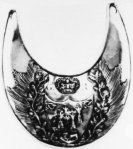 A photo by Philip Haythornthwaite from an auction catalogue, sent to me in 1983, shows a silver gorget, struck with the design of a crown and GR III[?] over one version of the arms of Stafford – Staffordshire knots over castle over lion passant guardant – within a wreath of oak leaves and a rayed star.
A photo by Philip Haythornthwaite from an auction catalogue, sent to me in 1983, shows a silver gorget, struck with the design of a crown and GR III[?] over one version of the arms of Stafford – Staffordshire knots over castle over lion passant guardant – within a wreath of oak leaves and a rayed star.
Note: therefore officers’ buttons and other metal were also silvered.
A “very beautiful stand of colours” was presented on 30 October 1798 by Mrs Clifford. The colours – perhaps both – bore another version of the arms of Stafford, described as “a Castle between four Lions; crest, a true lover’s knot”. The field would have been red, the lions gold, the castle white or silver, possibly above a blue base with a silver fish. The knot would have been the familiar Staffordshire knot, oddly described here. One or both colours bore the motto “Pro Aris et Focis”.
[Staffordshire Advertiser 5 May, 20 Oct, 3 November 1798, 8, 22 November 1800.]
Stone Volunteer Association / Stone Volunteer Infantry
Earliest commissions dated June 8 1798. One company. Captain John Jervis.
Their first appearance in uniform and with side arms was on 16 September 1798. The corps included a band.
[Staffordshire Advertiser, 22 September 1798.]
Tamworth Armed Association / Tamworth Volunteer Association
Earliest commissions dated July 6 1798. Two companies. Captain Walter Lyon, Captain Edward Dickinson (Dickenson).
Colours were presented by Mrs Peel on 26 June 1799 – a Union flag for the King’s colour, and a regimental colour bearing the arms of Tamworth.
[Charles Ferrers Palmer, The History of the Town and Castle of Tamworth …, Tamworth, 1845.]
Walsall Volunteers
Served as volunteers. Date of earliest commissions 25 July 1798. One company. Captain Richard Jesson. Colours were presented by Miss Leigh on 23 September 1799.
[Swinney’s Birmingham Chronicle 26 September 1799. Derby Mercury, 3 October 1799.]
Wednesbury Loyal Volunteer Association / Wednesbury Loyal Association
Earliest commissions dated 1 May 1798 in London Gazette. One company. Captain Samuel Addison. Two drums.
From resolutions of 30 April 1798:
That a plain neat uniform, consisting of a blue coat, with scarlet collar, military lappel, scarlet edging and small gilt buttons having the letters W.L.A engraved thereon and a crown over the letters, a white kerseymere waistcoat, and blue cloth pantaloons, be found and provided by every member of this assoc. at his own individual expense but it is the wish of the assoc. to receive arms from Government.
Notes: “military lapel” and “scarlet edging” imply blue lapels edged scarlet. Not clear whether cuffs are scarlet or blue edged scarlet. “Pantaloons” implies black half gaiters. No description of headwear.
[Letter from Robert Williams, The Blackcountryman Vol 7 No 1]
West Bromwich Loyal Infantry Association / West Bromwich Volunteer Association
Earliest commissions dated 4 June 1798. One company. Captain Richard Jesson. Colours presented 6 July 1798.
From resolutions of 25 April 1798:
That every Associator shall be expected to provide himself with a Gun, and Bayonet, and Cartridge-box; or with a Pike, at his Option; with a blue Coat, having a red Collar, a round Hat, and Cockade.
Notes: not clear whether cuffs are blue or red. Presumably no fur crest to round hat, but colour of feather not mentioned. No description of legwear.
[Boulton papers MS 3782/18/8, Birmingham Archives. Martin Smith, “Conflict and Society in Late Eighteenth century Birmingham,” D Phil thesis, Cambridge, December 1977, typescript in Birmingham reference library.]
Whittington Volunteer Association / Whittington Volunteers
Earliest commissions dated 5 June 1798. One company. Captain Richard Dyott.
From resolutions of 20 April 1798:
… shall at their own expense provide such uniform as shall be agreed upon by the officers, which uniform shall be as little expensive as may be.
From undated regulations:
The uniform is to be Blue Coat lapelled, white waistcoat, white leather breeches, Black Cloth Half gaiters & Round Hat with Black feather & Cockade.
Supplied by Ordnance with 95 Prussian muskets, bayonets, scabbards, slings, cartridge boxes, shoulder belts, cross belts for bayonets with plates, two drums & sticks, cases, carriages, drummers’ hangers & scabbards, belts for hangers with plates, three serjeants’ pikes.
[Staffordshire Record Office D661/9/6/1, manuscript resolutions and half indenture.]
Wolverhampton Loyal Volunteer Association / Wolverhampton Loyal Volunteer Infantry
Earliest commissions dated 14 August 1798. Two companies. Captain-Commandant Lewis Clutterbuck.
“… a blue uniform.”
[James Amphlett, The Newspaper Press in Part of the Last Century …, London, 1860]

